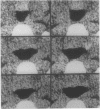Abstract
BACKGROUND: This study aimed to determine whether reducing the expiratory pressure during nasal positive airway pressure for reasons of comfort causes a substantial decrease in the upper airway calibre. METHODS: Eight patients with obstructive sleep apnoea were studied. Continuous computed tomography (each run lasting 12 seconds) was used to measure minimum and maximum pharyngeal cross sectional areas at the velopharynx and the hypopharynx. Pharyngeal areas were measured while patients were awake and breathing without assistance, during the application of 12 cm H2O continuous positive airway pressure, and during bi-level positive airway pressure with an inspiratory pressure of 12 cm H2O and an expiratory pressure of 6 cm H2O. RESULTS: Nasal continuous positive airway pressure significantly increased the mean minimum and maximum upper airway areas at both the velopharynx and the hypopharynx compared with normal unassisted breathing. Bi-level positive airway pressure did not show a statistically significant increase in the minimum upper airway area at either level compared with normal unassisted breathing. The minimum areas of the velopharynx and hypopharynx were smaller with bi-level than continuous positive airways pressure in six of eight and eight of eight patients respectively but these were still greater than during unassisted breathing in seven of eight and six of eight patients respectively. CONCLUSIONS: Continuous positive airway pressure at 12 cm H2O is more effective in splinting the pharynx open than bi-level positive airway pressure with an inspiratory positive airway pressure of 12 cm H2O and an expiratory pressure of 6 cm H2O in patients with obstructive sleep apnoea during wakefulness, suggesting an important role for expiratory positive airway pressure. The clinical importance of this finding needs to be evaluated during sleep.
Full text
PDF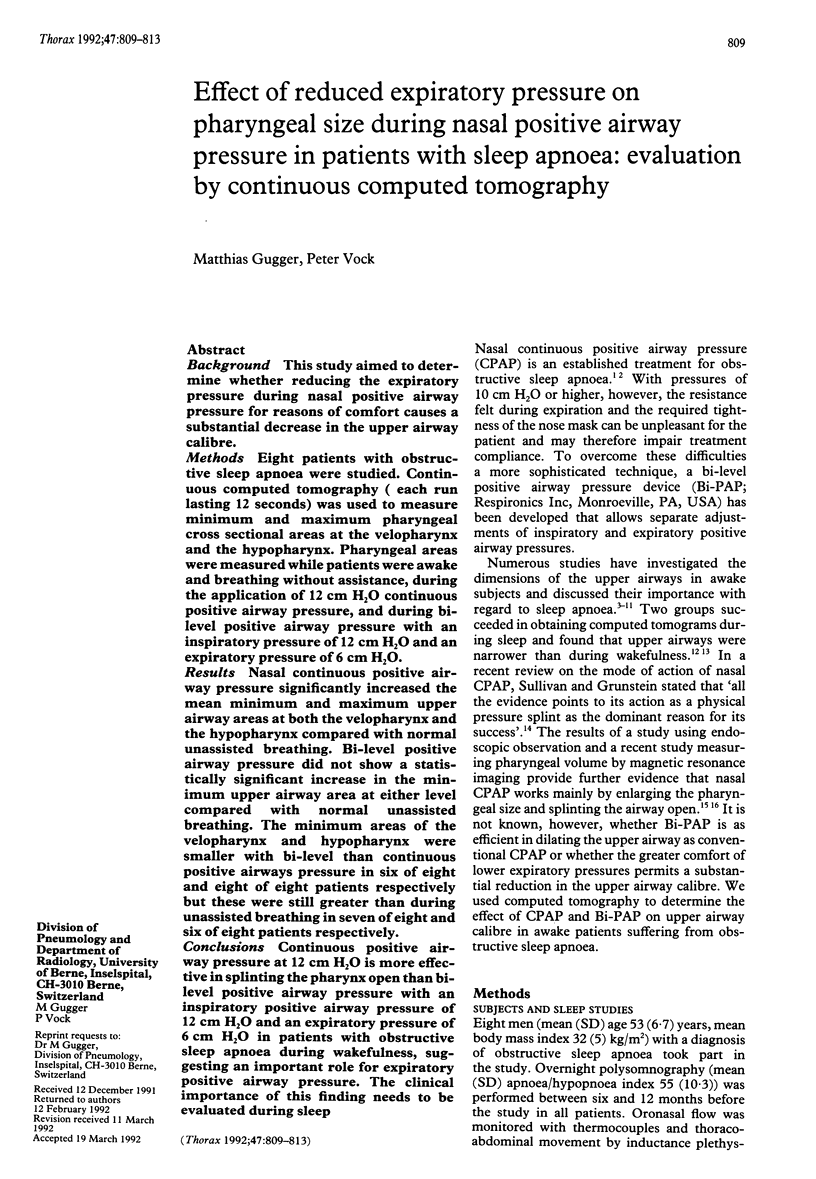
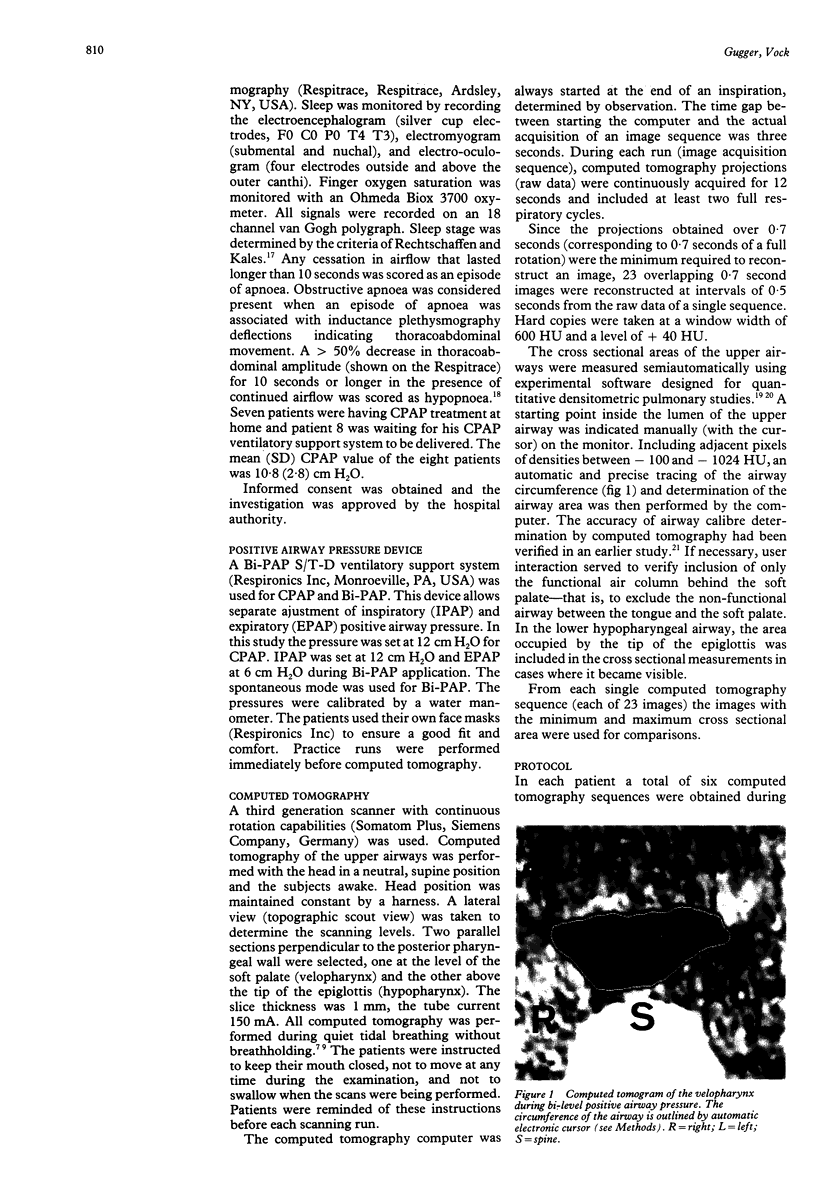
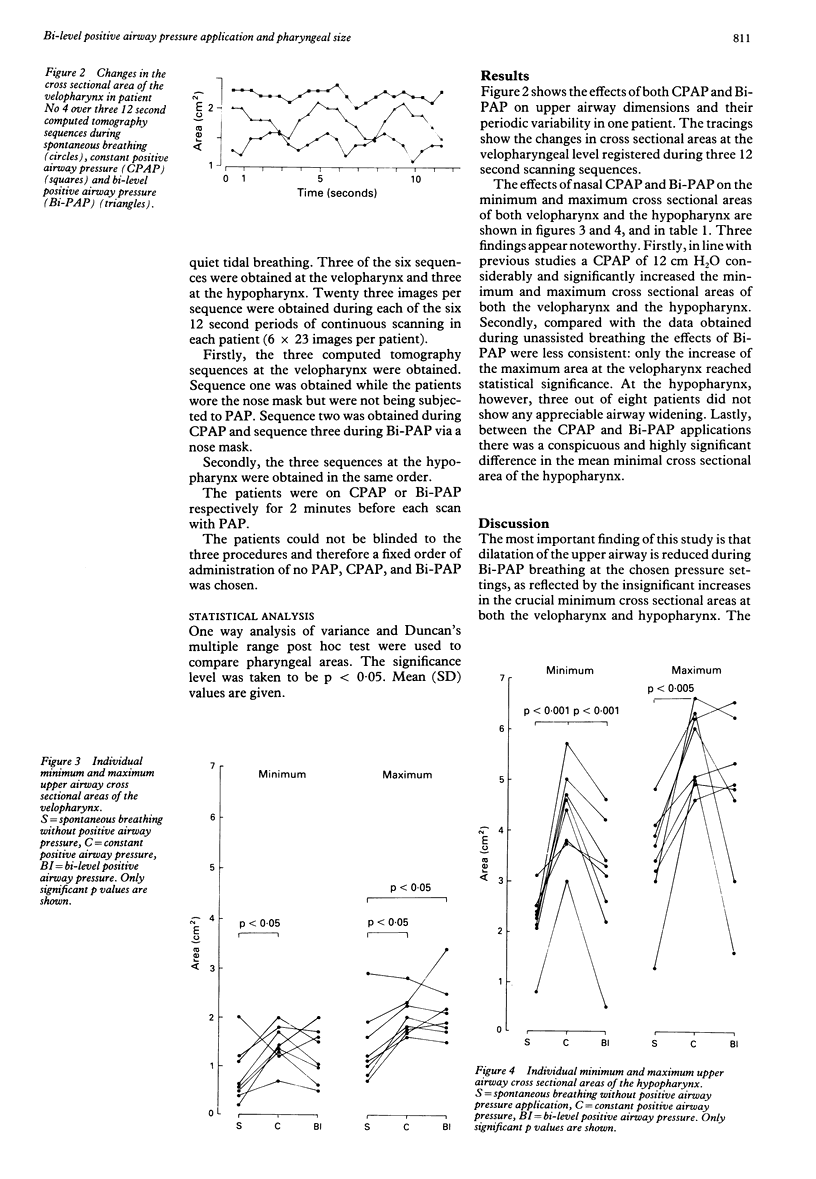
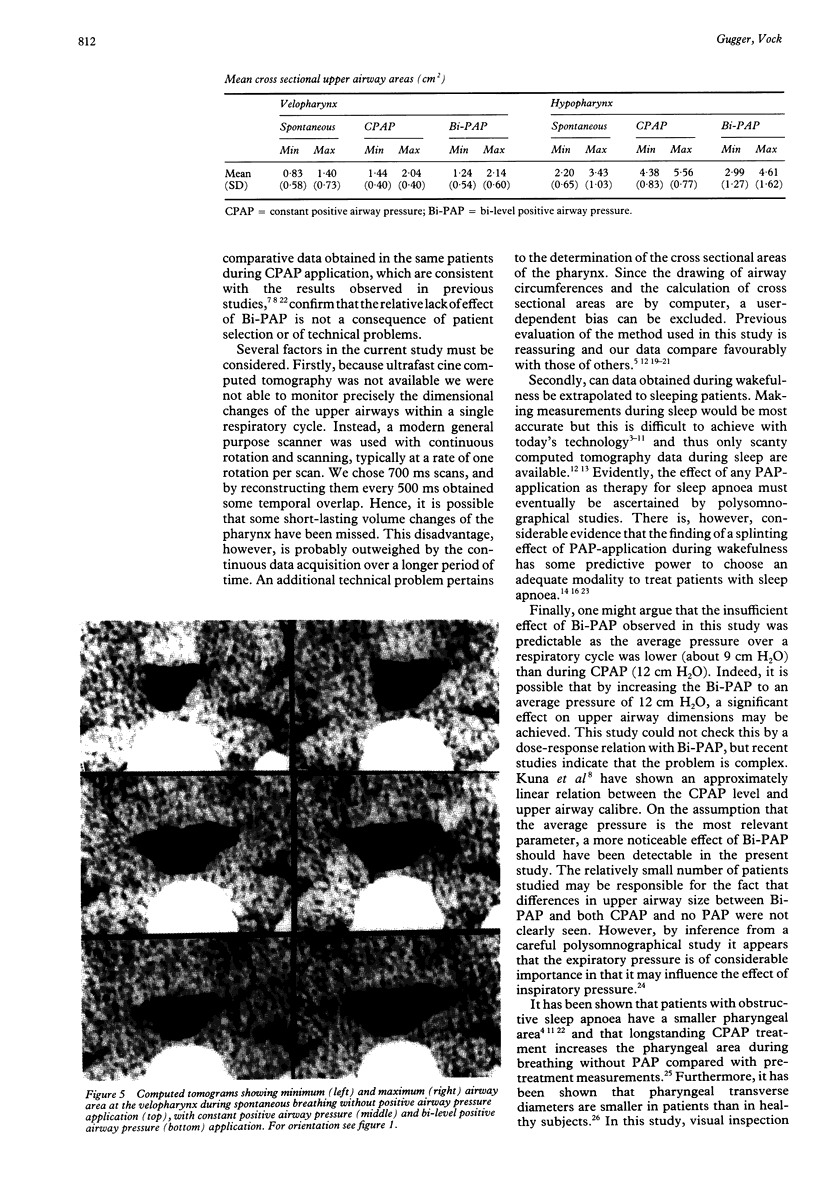
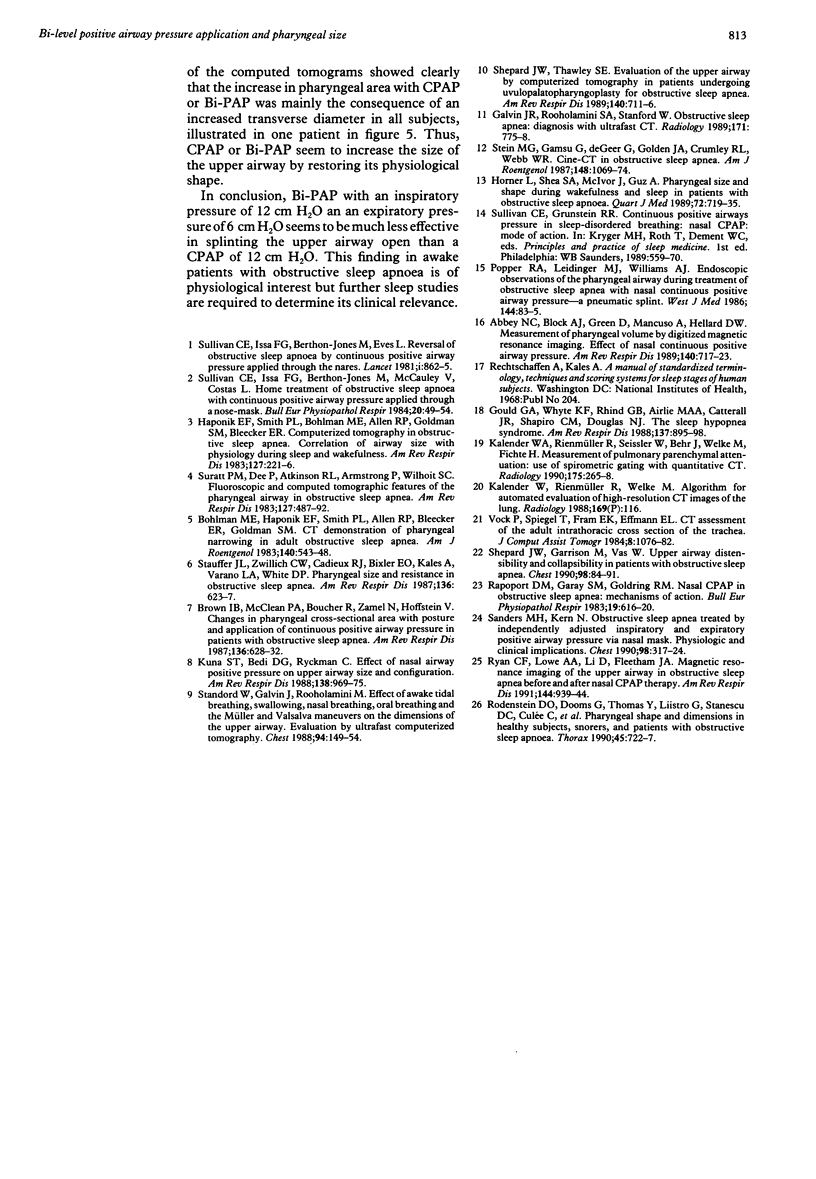
Images in this article
Selected References
These references are in PubMed. This may not be the complete list of references from this article.
- Abbey N. C., Block A. J., Green D., Mancuso A., Hellard D. W. Measurement of pharyngeal volume by digitized magnetic resonance imaging. Effect of nasal continuous positive airway pressure. Am Rev Respir Dis. 1989 Sep;140(3):717–723. doi: 10.1164/ajrccm/140.3.717. [DOI] [PubMed] [Google Scholar]
- Bohlman M. E., Haponik E. F., Smith P. L., Allen R. P., Bleecker E. R., Goldman S. M. CT demonstration of pharyngeal narrowing in adult obstructive sleep apnea. AJR Am J Roentgenol. 1983 Mar;140(3):543–548. doi: 10.2214/ajr.140.3.543. [DOI] [PubMed] [Google Scholar]
- Brown I. B., McClean P. A., Boucher R., Zamel N., Hoffstein V. Changes in pharyngeal cross-sectional area with posture and application of continuous positive airway pressure in patients with obstructive sleep apnea. Am Rev Respir Dis. 1987 Sep;136(3):628–632. doi: 10.1164/ajrccm/136.3.628. [DOI] [PubMed] [Google Scholar]
- Galvin J. R., Rooholamini S. A., Stanford W. Obstructive sleep apnea: diagnosis with ultrafast CT. Radiology. 1989 Jun;171(3):775–778. doi: 10.1148/radiology.171.3.2717750. [DOI] [PubMed] [Google Scholar]
- Gould G. A., Whyte K. F., Rhind G. B., Airlie M. A., Catterall J. R., Shapiro C. M., Douglas N. J. The sleep hypopnea syndrome. Am Rev Respir Dis. 1988 Apr;137(4):895–898. doi: 10.1164/ajrccm/137.4.895. [DOI] [PubMed] [Google Scholar]
- Haponik E. F., Smith P. L., Bohlman M. E., Allen R. P., Goldman S. M., Bleecker E. R. Computerized tomography in obstructive sleep apnea. Correlation of airway size with physiology during sleep and wakefulness. Am Rev Respir Dis. 1983 Feb;127(2):221–226. doi: 10.1164/arrd.1983.127.2.221. [DOI] [PubMed] [Google Scholar]
- Horner R. L., Shea S. A., McIvor J., Guz A. Pharyngeal size and shape during wakefulness and sleep in patients with obstructive sleep apnoea. Q J Med. 1989 Aug;72(268):719–735. [PubMed] [Google Scholar]
- Kalender W. A., Rienmüller R., Seissler W., Behr J., Welke M., Fichte H. Measurement of pulmonary parenchymal attenuation: use of spirometric gating with quantitative CT. Radiology. 1990 Apr;175(1):265–268. doi: 10.1148/radiology.175.1.2315492. [DOI] [PubMed] [Google Scholar]
- Kuna S. T., Bedi D. G., Ryckman C. Effect of nasal airway positive pressure on upper airway size and configuration. Am Rev Respir Dis. 1988 Oct;138(4):969–975. doi: 10.1164/ajrccm/138.4.969. [DOI] [PubMed] [Google Scholar]
- Popper R. A., Leidinger M. J., Williams A. J. Endoscopic observations of the pharyngeal airway during treatment of obstructive sleep apnea with nasal continuous positive airway pressure--a pneumatic splint. West J Med. 1986 Jan;144(1):83–85. [PMC free article] [PubMed] [Google Scholar]
- Rapoport D. M., Garay S. M., Goldring R. M. Nasal CPAP in obstructive sleep apnea: mechanisms of action. Bull Eur Physiopathol Respir. 1983 Nov-Dec;19(6):616–620. [PubMed] [Google Scholar]
- Rodenstein D. O., Dooms G., Thomas Y., Liistro G., Stanescu D. C., Culée C., Aubert-Tulkens G. Pharyngeal shape and dimensions in healthy subjects, snorers, and patients with obstructive sleep apnoea. Thorax. 1990 Oct;45(10):722–727. doi: 10.1136/thx.45.10.722. [DOI] [PMC free article] [PubMed] [Google Scholar]
- Ryan C. F., Lowe A. A., Li D., Fleetham J. A. Magnetic resonance imaging of the upper airway in obstructive sleep apnea before and after chronic nasal continuous positive airway pressure therapy. Am Rev Respir Dis. 1991 Oct;144(4):939–944. doi: 10.1164/ajrccm/144.4.939. [DOI] [PubMed] [Google Scholar]
- Sanders M. H., Kern N. Obstructive sleep apnea treated by independently adjusted inspiratory and expiratory positive airway pressures via nasal mask. Physiologic and clinical implications. Chest. 1990 Aug;98(2):317–324. doi: 10.1378/chest.98.2.317. [DOI] [PubMed] [Google Scholar]
- Shepard J. W., Jr, Garrison M., Vas W. Upper airway distensibility and collapsibility in patients with obstructive sleep apnea. Chest. 1990 Jul;98(1):84–91. doi: 10.1378/chest.98.1.84. [DOI] [PubMed] [Google Scholar]
- Shepard J. W., Jr, Thawley S. E. Evaluation of the upper airway by computerized tomography in patients undergoing uvulopalatopharyngoplasty for obstructive sleep apnea. Am Rev Respir Dis. 1989 Sep;140(3):711–716. doi: 10.1164/ajrccm/140.3.711. [DOI] [PubMed] [Google Scholar]
- Stanford W., Galvin J., Rooholamini M. Effects of awake tidal breathing, swallowing, nasal breathing, oral breathing and the Müller and Valsalva maneuvers on the dimensions of the upper airway. Evaluation by ultrafast computerized tomography. Chest. 1988 Jul;94(1):149–154. doi: 10.1378/chest.94.1.149. [DOI] [PubMed] [Google Scholar]
- Stauffer J. L., Zwillich C. W., Cadieux R. J., Bixler E. O., Kales A., Varano L. A., White D. P. Pharyngeal size and resistance in obstructive sleep apnea. Am Rev Respir Dis. 1987 Sep;136(3):623–627. doi: 10.1164/ajrccm/136.3.623. [DOI] [PubMed] [Google Scholar]
- Stein M. G., Gamsu G., de Geer G., Golden J. A., Crumley R. L., Webb W. R. Cine CT in obstructive sleep apnea. AJR Am J Roentgenol. 1987 Jun;148(6):1069–1074. doi: 10.2214/ajr.148.6.1069. [DOI] [PubMed] [Google Scholar]
- Sullivan C. E., Issa F. G., Berthon-Jones M., Eves L. Reversal of obstructive sleep apnoea by continuous positive airway pressure applied through the nares. Lancet. 1981 Apr 18;1(8225):862–865. doi: 10.1016/s0140-6736(81)92140-1. [DOI] [PubMed] [Google Scholar]
- Sullivan C. E., Issa F. G., Berthon-Jones M., McCauley V. B., Costas L. J. Home treatment of obstructive sleep apnoea with continuous positive airway pressure applied through a nose-mask. Bull Eur Physiopathol Respir. 1984 Jan-Feb;20(1):49–54. [PubMed] [Google Scholar]
- Suratt P. M., Dee P., Atkinson R. L., Armstrong P., Wilhoit S. C. Fluoroscopic and computed tomographic features of the pharyngeal airway in obstructive sleep apnea. Am Rev Respir Dis. 1983 Apr;127(4):487–492. doi: 10.1164/arrd.1983.127.4.487. [DOI] [PubMed] [Google Scholar]
- Vock P., Spiegel T., Fram E. K., Effmann E. L. CT assessment of the adult intrathoracic cross section of the trachea. J Comput Assist Tomogr. 1984 Dec;8(6):1076–1082. doi: 10.1097/00004728-198412000-00007. [DOI] [PubMed] [Google Scholar]




